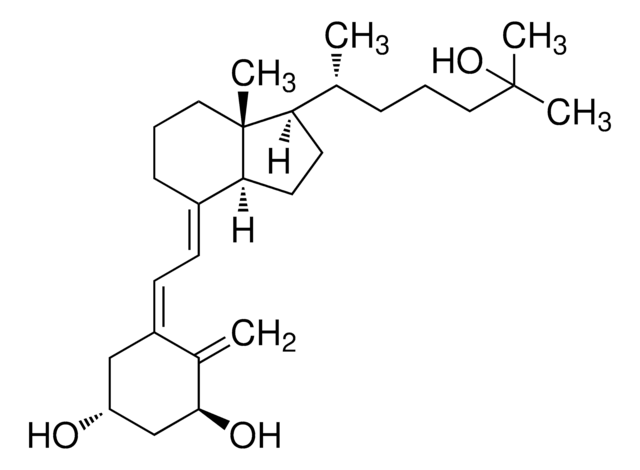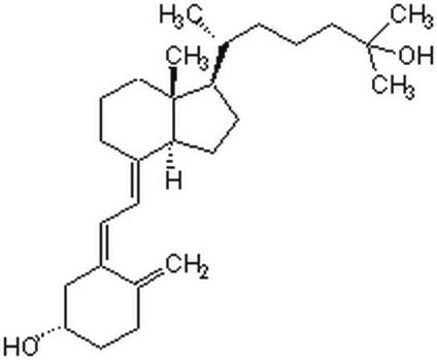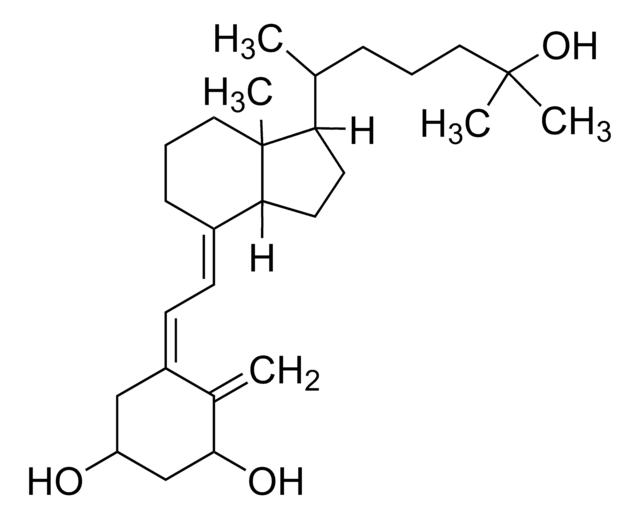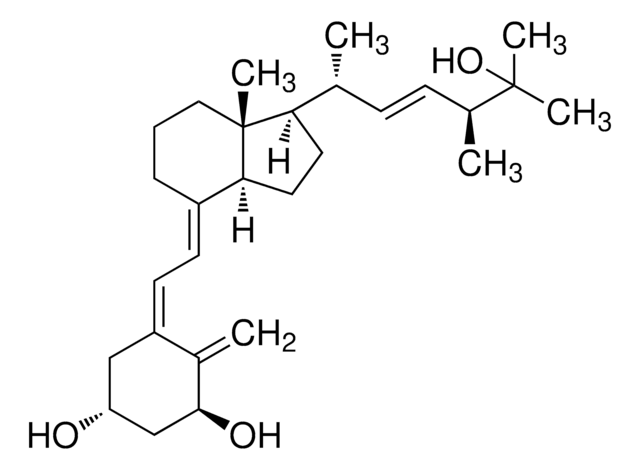679101
Vitamin D3, 1α, 25-Dihydroxy-
CAS 32222-06-3 prevents the development of clinical diabetes in NOD mice, an animal model of human autoimmune diabetes.
Sinónimos:
Vitamin D3, 1α, 25-Dihydroxy-, 1,25-(OH)₂-D₃, Calcitriol
About This Item
Productos recomendados
Nivel de calidad
Análisis
≥95% (HPLC)
formulario
solid
fabricante / nombre comercial
Calbiochem®
condiciones de almacenamiento
OK to freeze
protect from light
solubilidad
DMSO: 50 mg/mL
ethanol: soluble
Condiciones de envío
wet ice
temp. de almacenamiento
−70°C
InChI
1S/C27H44O3/c1-18(8-6-14-26(3,4)30)23-12-13-24-20(9-7-15-27(23,24)5)10-11-21-16-22(28)17-25(29)19(21)2/h10-11,18,22-25,28-30H,2,6-9,12-17H2,1,3-5H3/b20-10+,21-11-/t18-,22-,23-,24+,25+,27-/m1/s1
Clave InChI
GMRQFYUYWCNGIN-NKMMMXOESA-N
Descripción general
Aplicación
- Vitamin D deficiency or resistance and hypophosphatemia.: Discusses the complex interplay between vitamin D metabolism and phosphate homeostasis, emphasizing the crucial role of 1α,25-Dihydroxy-vitamin D3 in managing and understanding bone mineral disorders and their systemic implications (Sarathi et al., 2024).
- Altered Expression of Vitamin D Metabolism Genes and Circulating MicroRNAs in PBMCs of Patients with Type 1 Diabetes.: Investigates how 1α,25-Dihydroxy-vitamin D3 influences gene expression and microRNA profiles in peripheral blood mononuclear cells, linking vitamin D status with autoimmune processes in diabetes (Al-Nakhle et al., 2023).
- 1α,25-Dihydroxyvitamin D(3) Improves Follicular Development and Steroid Hormone Biosynthesis by Regulating Vitamin D Receptor in the Layers Model.: Demonstrates the role of 1α,25-Dihydroxy-vitamin D3 in enhancing reproductive functions and hormonal balance through its action on the vitamin D receptor, providing insights into fertility management (Cheng et al., 2023).
- 1α,25(OH)(2)D(3) Promotes the Autophagy of Porcine Ovarian Granulosa Cells as a Protective Mechanism against ROS through the BNIP3/PINK1 Pathway.: This study presents the protective effects of 1α,25-Dihydroxy-vitamin D3 on ovarian cells under oxidative stress, suggesting mechanisms that could be exploited for therapeutic interventions in reproductive health (Wang et al., 2023).
Envase
Advertencia
Reconstitución
Otras notas
Hannun, Y.A. 1994. J. Biol. Chem.269, 3125.
Mathieu, C., et al. 1994. Diabetologica37, 552.
Thomasset, M. 1994. Pathol. Biol. 42, 163.
Horton, W.E., Jr., et al. 1991. J. Biol. Chem.266, 24804.
Larsen, C.G., et al. 1991. Biochem. Biophys. Res. Commun.176, 1020.
Thavarajah, M., et al. 1991. Biochem. Biophys. Res. Commun.176, 1189.
Wakasugi, M., et al. 1991. Prostaglandins42, 127.
Matsumoto, K., et al. 1990. Biochem. Biophys. Res. Commun.166, 916.
Simpson, R.U., et al. 1989. J. Biol. Chem.264, 19710.
DeLuca, H.F., and Schnoes, H.K. 1983. Annu. Rev. Biochem.52, 411.
Información legal
Palabra de señalización
Danger
Frases de peligro
Consejos de prudencia
Clasificaciones de peligro
Acute Tox. 1 Oral - Acute Tox. 2 Dermal - Acute Tox. 2 Inhalation - STOT RE 1
Código de clase de almacenamiento
6.1A - Combustible acute toxic Cat. 1 and 2 / very toxic hazardous materials
Clase de riesgo para el agua (WGK)
WGK 2
Punto de inflamabilidad (°F)
Not applicable
Punto de inflamabilidad (°C)
Not applicable
Certificados de análisis (COA)
Busque Certificados de análisis (COA) introduciendo el número de lote del producto. Los números de lote se encuentran en la etiqueta del producto después de las palabras «Lot» o «Batch»
¿Ya tiene este producto?
Encuentre la documentación para los productos que ha comprado recientemente en la Biblioteca de documentos.
Los clientes también vieron
Nuestro equipo de científicos tiene experiencia en todas las áreas de investigación: Ciencias de la vida, Ciencia de los materiales, Síntesis química, Cromatografía, Analítica y muchas otras.
Póngase en contacto con el Servicio técnico










